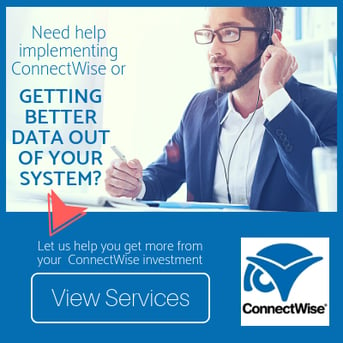Is this you?
You invested into a tech time, contract tracking software which in our industry is often referred to as Professional Services Automation (PSA) such as ConnectWise or Autotask. You believed that for all that flexibility that ConnectWise offered, you would be able to receive robust reporting and profitability tracking. But as a C-level executive, you have discovered that you need more than just a high-level view of our profitability—you need a way to gather data client-by-client and engineer-by-engineer, not just for the business as a whole. Why? In order to measure the profitability of your organization, you also need to be able to isolate different types of clients and jobs and measure the profitability on a micro scale. And without any way to dig into the data presented by ConnectWise, you could find yourself spending days trying to gather the profitability insights necessary to make key business decisions. And that is the foundation of this blog. Together with New Haven Technologies, this blog will address reasons why profitability tracking is difficult and which metrics need to be measured to help you understand and improve on your ability to measure profitability.
Time Tracking and Reporting Difficulty Level: High
The time-tracking problems that make true profitability insights so difficult to uncover don’t necessarily stem from issues with the ConnectWise platform, itself. Rather, they are often rooted in the workflows and processes that are directly tied to time input from your technicians and engineers.
Time-tracking can be a tedious and time-consuming process that is important for many reasons, but not always embraced or its value fully understood. For example, a good engineer will be relentlessly focused on getting the technical job done and making the client happy. And while client satisfaction is ultimately the measurement of a job well done, many engineers will overlook time-tracking as a function that draws attention away from the job, or less-important task to the overall goal of problem-solving and customer satisfaction.
But herein lies the problem: when engineers see time-tracking simply as an administrative headache, your ConnectWise platform gets loaded with inaccurate data. Or worse, you end up with more than one engineer failing to record entire weeks’ worth of work. Questions like the following and the details that answer these questions are forever lost in the details that go unrecorded.
- How long did the job actually take?
- What was actually performed?
- How long should that job take in the future and most importantly, are we making money or losing money on this client?
That’s why MSP leaders can’t take a set-it-and-forget-it approach to PSA software. There have to be policies and tools to back the policies if managed properly, help you track profitability and make informed decisions that propel your business forward.
The key to overcoming time-tracking and reporting difficulties often comes down to a carrot-and-stick strategy. Engineers are incentivized to track their hours because that data will contribute to better client contracts, which will result in more effective pay structures for engineers. When necessary, the “stick” side of the conversation is that engineers absolutely need their 40 hours in the PSA software—if they aren’t getting 40 hours tracked, they aren’t really part of your business.
As a side note, these forty hours are not necessarily billable hours, but the assumption is that your Engineers work forty hours and those hours need to be accounted for. If you don’t have any clear visibility into engineer hours, don’t try to boil the ocean. Start by getting all engineers to track 40 hours per week, regardless of the billable-hour percentages. Then, gradually, you can refine the process and set goals to get more accurate data into your PSA software.
The bottom line is that if your engineers don’t record time, you have zero chance of effectively managing your profitability through your PSA software. Once you have visibility into accurate time records, you can start optimizing profitability based on labor cost distribution and talent allocation.
The Main Mistake MSP Leaders Make in Understanding Profitability
More and more, the profitability of MSPs depends on your service value and all the costs associated with it. And for every MSP, labor is the largest investment and cost that impacts profitability.
With ConnectWise, you can see the overall profitability of your business, and as mentioned earlier, that’s a good start. But how do you isolate customers that actually cost you money? How do you figure out if a client is profitable or if you should provide a discount for services (that won’t erode your profit margin down the road)?
The MSP profitability is more than a view of the quarterly report's line at the bottom. Genuine MSP profitability revolves around the never-ending search for minutiae and a closer look at all the granular details surrounding each client engagement and the contribution of every engineer. These essential details enable decisions to be made at face value when, as a whole, profitability could simply be a mirage that conceals clients.
The objective to maximize MSP profitability by pivoting from macro to micro perspective requires the acceptance that overall profitability can be healthy while still having a fair number of broken revenue generating relationships. When labor costs measured in total coupled with labor costs by client can be reconciled with client's revenue, an MSP can see exactly what is generating a profit.
To isolate profit, labor has to be tracked at two levels:
- The Macro Level: This is the side where you determine the mix of client work and internal hours across your entire pool of engineers. You need to know how much of your engineering investments are actually deployed for the benefit of your clients. Understanding the mix of billable hours and internal workflows shows you how much slack you have to make adjustments. Calculating this mix incorrectly will cause problems in tracking/optimizing your true profitability.
- The Micro Level: Focusing only on the client hours, this side of labor-tracking is focused on whether hours are spent appropriately based on skill levels and how much you charge clients. For many ConnectWise users, it’s easy to make the mistake of guessing at cost ratios. On a $1,000 contract, you might assume that 50% of that goes to the costs of providing your services. But if you’re just guessing because you don’t have granular insights into engineering hours, inaccuracies will multiply behind your ConnectWise dashboard. In reality, costs will vary month-to-month. Without visibility into the specifics, profitability tracking will prove ineffective.
Getting a handle on your labor costs at both the macro and micro levels is the only way to properly evaluate individual clients and contracts. Being able to validate where costs come from in each client relationship comes from a drill-down into the specifics of engineering hours. And unfortunately, that’s not something you can do with ConnectWise, especially considering that non-billable hours aren’t included in W2 costs in the PSA software.
So, you know you have to go deeper than the ConnectWise dashboard to truly understand your profitability. But how exactly can you capture and measure metrics to get accurate profitability insights?
Key Metrics for Understanding Client Profitability
 If you want to improve your business, you have to evaluate clients individually and find ways to boost profit margins. That means you need a net operating profit for each client, not just an average across the business like you might see in ConnectWise.
If you want to improve your business, you have to evaluate clients individually and find ways to boost profit margins. That means you need a net operating profit for each client, not just an average across the business like you might see in ConnectWise.
The first step is to determine the baseline for your business. Understanding the current state of your business profitability gives you a foundation for evaluating net operating profit on a client level.
But once you’re ready to determine client net operating profits, here’s what you’ll need to know:
- Contribution Margin: Calculate how much you charge a client (revenue) and subtract any third-party payments for the service (for example, equipment and software purchases on behalf of the client). This gives you a contribution margin.
- Net Operating Profit: From the contribution margin, you can determine the net operating profit. Here, you’ll have to take labor costs (the hour-by-hour engineer entries) and allocate them against each client to get W2 costs. Subtract W2 costs from your contribution margin to get a net operating profit for each client.
With these key metrics, you’ll be able to see clearly which clients are good and which aren’t so good for your business. Sometimes, you’ll have to talk to a client and resolve issues in the relationship. Other times, you’ll look at all the data and see that the client just isn’t a good fit. And because you have so much insight into profitability, you can rest easy knowing that cutting the relationship off is better for your business than powering through.
The difficulty for MSP leaders comes when you have to make judgment calls about when it’s time to end a client relationship. In many cases, net operating profits are upside down as you first stabilize the client environment. Then, once that environment is stable, your net operating profit stabilizes as well.
A good rule of thumb is to aim for a break-even point around the 6-month mark in the client relationship. It’s important to be flexible and understand when a client will need more or less time. And as long as you’re evaluating from an annual perspective, you should have a good idea of whether or not effective hourly rates are trending in the right direction.
Next Steps for MSP Leaders in Need of Deeper Profitability Insights
ConnectWise is an outstanding PSA platform for managing the day-to-day transactions in your MSP business. Their focus and passion is on getting things right at the detail transaction level—and they do a great job of it.
If you’re feeling like you need deeper information to make larger-scale business decisions, your next steps should be to:
- Encourage/require engineers to track their hours accurately
- Record the costs of third-party products you sell in monthly invoices using ConnectWise
- Consciously focus on scheduling time to work on your business, not just in your business. (It may be tempting to dive into technical issues with the engineers, but you’re the only one who can make higher-level decisions to improve the business.)
As you take these next steps, it’s important to avoid some of the pitfalls of deeper profitability tracking.
First, don’t assume that your imperfect data is useless—its’ the best you have, and you have that data to use to your advantage.
Second, don’t get caught thinking that if your ConnectWise data is a mess, moving to a new PSA platform will fix it. It’s all about the processes you have in place. Moving to a new PSA platform and using the same workflow will result in the same mess of data.
And third, remember that labor is your biggest cost. If it’s managed poorly, you’ll never be able to trust your profitability insights. Get a handle on labor costs both internal and external.
If you want to know more about which metrics to measure, establish policies to manage your engineers and technicians and discover how to isolate your data to gain visibility into your profitability at every level, set up a meeting to talk. Not every company requires the same set of remedies. We ask a few questions and figure out where you are and what needs to be done to get you to your goals quickly.
FAQs
1. What is MSP profitability and why is it important?
MSP profitability is the capability of a managed service provider to bring in net profit after accounting for all expenses. It matters because it determines how sustainable and valuable an MSP business will be in the long-term.
2. What are the key profit margins MSPs should track?
MSPs should monitor gross margin, EBITDA margin, and net margin. These metrics help MSPs understand their financial health from different perspectives and identify areas for improvement.
3. What are the most common mistakes MSPs make when measuring profitability?
The biggest pitfall is that a lot of MSPs focus on service metrics (like processes, ticket backlog, or first-time resolution) instead of the financial KPIs (hourly effective rate and agreement gross profitability) that measure their profitability.
About the Authors
Dave Keller is the founder and Chief Consulting Officer of New Haven Technologies LLC. Dave has spent over 30 years in the industry in a variety of roles in both business management and technology engineering and is passionate about finding ways to use data and technology to streamline processes and make better decisions. Dave’s career includes managing a business unit responsible for $185 million in annual revenue at Apple Computer (now Apple Inc.); software development to support the first recombinant DNA technology manufacturing plant in the world at Eli Lilly and Company; business operations management as Chief Operating Officer of Desktop Resources, Inc., a fast-growing MSP in Indianapolis, Indiana.
Josh Peterson is the founder and CEO of Bering McKinley consulting services and the mastermind behind the Business Destination Planning program and peer groups helping business owners decide what they want to get out of their business. Josh’s 14 years of management consulting and Connectwise implementation experience has helped countless business owners avoid expensive mistakes while delivering a formula for growing an MSP business. Peer teams, finance, sales, and operations are Josh expertise.




